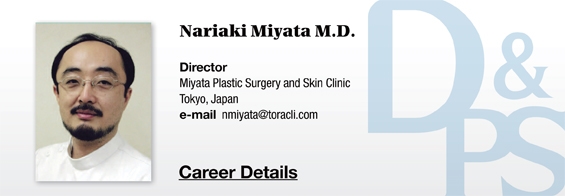
Patients need to understand lifting alone can improve sagging but is not sufficient to rejuvenate the overall countenance. They also need to be aware of the impact of deeper structure atrophy. It helps to use a mirror to demonstrate on the patient’s face during consultation.
When I see American plastic surgeons demonstrate injection techniques at academic conferences, I think they look awkward. Even when the skin surface is slightly bumpy after treatment, they praise each other saying the result is “excellent.”I cannot help feeling skeptical. Japanese patients do not accept even a slight anomaly or awkwardness in their facial expressions after treatment. As mentioned already, you may not see a Japanese patient express their dismay directly to you but will hear back from the patient in a form of a lawsuit. Japanese patients are very concerned with the little details, which necessitates the doctors to be the same.
Japanese patients are also overly concerned about the nasolabial folds.I explain that the overall contour will be corrected before focusing on detailed areas. But if the nasolabial folds are not immediately improved, the patient is unlikely to be satisfied with the treatment. In the contouring procedure, I use small amounts of dermal filler to improve the nasolabial folds to increase patient satisfaction. It goes without saying that one should inform the patient of this before treatment.
[Advertisement] MAGNUM(Q-switched Nd:YAG Laser) – Manufacturer: (www.i-dana.com)]
Many Japanesepatients are also averse to botulinum toxin injections. For some, the word “toxin” is scary enough to turn them away from the treatment. Others are worried that botulinum toxin injections make the face expressionless and unnatural. This may have something to do with the fact that uniquely Japanese facial expressions rely on subtle muscle movements. In the Western culture, lively and clearly expressive facial and body movements are attractive. On the other hand, the Japanese think that slight narrowing of the eyes or close-lipped smile are desirable. This may be the reason so many Japanese patients are unwilling to receive botulinum toxin injections. If you do not explain all the risks and outcomes of the procedure, you may have to deal with the patient’s wrath for months to come.
It is very common to see Japanese patients be overly concerned with minute details. I am certain that sometimes Korean patients are similar as well.
My personal impression is that some Korean doctors perform treatments extemporaneously without fully checking with the patient beforehand. This does happen in Japan as well but much less frequently. Japanese patients do not like receiving a treatment getting sufficient explanation about it. Even if such a treatment brings favorable results, they will not return to the doctor. It is hard to generalize but it would help to understand that there are many patients who are very sensitive about little details in Japan.
-To be continued-




















